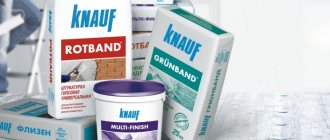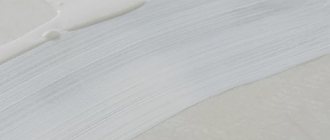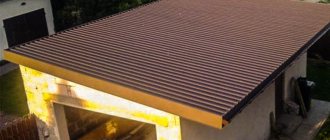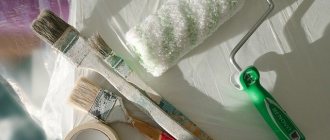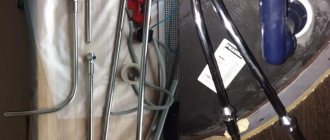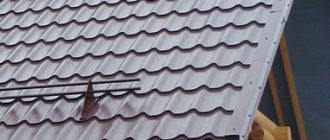Once upon a time, finishing work was limited to the most ordinary whitewash and wallpaper, which was glued to even the most uneven slabs. Sometimes large cracks were sealed with putty and that was all. As a result, many probably remember not the most even walls and air bubbles under the wallpaper, which could turn into unsightly tears with any careless movement.
Today, perfectly smooth surfaces are in fashion. In addition, walls are often painted or finishing material (for example, siding) is laid on them. All this requires preparatory work, which includes applying finishing putty. Thanks to this, it is possible not only to level the walls for painting or wallpaper, but also to improve the sound insulation and strength characteristics of the surface. However, before starting work, it is worth choosing the best composition and studying the types of mixtures offered on the market.
Features of finishing putty
The final putty composition should have the following features:
- fine grain;
- snow-white color;
- gloss elements;
- good adhesion to the base.
The finishing mixture solution must have the following characteristics:
- have the consistency of liquid sour cream, but do not drip off the spatula and walls;
- a layer of less than 1 mm should hide the defects of the previous application and the drawing with a marker;
- lay on the surface with ease and do not reach for a spatula;
- do not crack after drying;
- have a homogeneous mass: without dirt inclusions, debris particles and pigment.
High-quality finishing putty is characterized by high adhesion and ease of application.
To ensure that puttying goes without problems, the choice of manufacturer is very important for the master plasterer.
How is it different from the usual
By regular we mean starting putty. The base and finishing mixtures are always paired from the same manufacturer. So they have the greatest compatibility and high adhesion. They differ from each other only in the size of the grains: for the starting one it is 0.2-0.3 mm, for the final one it is no more than 0.2 mm.
The finishing putty consists of fine powder, which distinguishes it from the starting putty mixture
Due to the coarse grain, starting putty is used to cover cracks and unevenness of plastered surfaces or joints of gypsum boards and other tile materials. The final composition is not suitable for these purposes.
Application area
Starting putty, in terms of its purpose and area of use, is somewhere in the middle between plaster and finishing putties. It is used for leveling various rough bases - concrete and brick walls, as well as plastered surfaces.
Unlike plaster, the basic putty composition uses a filler of a finer fraction. This allows you to obtain a finer surface structure after treatment than after plastering.
To ensure that the putty surface lasts as long as possible, it is recommended to use mixtures from the same manufacturer for plastering and puttying. Created using the same technologies using a mutually compatible set of components, they will be able to combine in the best possible way.
The starting putty differs from the finishing putty in the ability to apply a thicker layer, but at the same time, the base compositions differ from the finishing ones in having a coarser texture, which does not allow them to be used as a direct base for some finishing materials - paints and varnishes, wallpaper with a fine texture, etc. .
Unlike finishing types, starting mixtures can be applied in several stages, obtaining fairly thick layers up to 1.5 - 2 cm.
Using basic putty, you can repair minor defects in load-bearing surfaces: small deviations of the surface from the vertical or horizontal level, cracks and crevices in the wall, sinks, potholes in concrete and brick.
So, you should pay priority attention to the starting putty if you need:
- after installing the door or window frame, seal the resulting gap between it and the wall opening;
- fill grooves for electrical wiring in concrete and brick walls;
- seal the joints between the wall and floor slabs, as well as between other structures.
Why do you need finishing putty?
Finishing putty is needed for finishing surfaces, if they need to be made as even, smooth and glossy as possible. Surfaces painted using this putty will have a neat and noble appearance, and thin wallpaper will lie smoothly without gaps between the joints. The uniformity of the coating will not be spoiled by the translucent facing material.
Finishing putty gives the surface aesthetic qualities
All about putty
Putty is a special building material for leveling walls for subsequent finishing - painting or wallpaper. All putties, regardless of type, contain glue with mineral fillers.
In fact, this is a more modern type of plaster, which has a fine fraction, which allows you to achieve a smooth surface. Also, the putty has a light color, not showing through even through thin layers of paint, which allows you to achieve the most aesthetic result.
Putty and putty are the same thing. Both of these names are correct and can be used when writing.
Types of finishing putty
Like other finishing mixtures, finishing putty is classified into types.
Plaster
This is the most common finishing material, which has a number of advantages:
- sold both dry and ready-made, in bags and buckets of different weights;
- safe for health;
- hygroscopic, as it maintains optimal microflora in the room;
- plastic and therefore easy to apply to the surface;
- dries quickly, which reduces repair time;
- sands perfectly to a glossy finish;
- high level of adhesion;
- does not crack;
- no shrinkage;
- inexpensive.
Gypsum putty can mask surface imperfections
Disadvantages include:
- unacceptability of use in damp rooms (including the inability to work with it outside), as well as the rapid setting of the solution;
- short shelf life of both the dry mixture and the finished material.
The color is white or yellowish. The last option is often found among Russian manufacturers.
Cement based
An equally popular finishing product that has its advantages:
- can be found on sale both in powder and liquid form, in packages of different weights, which is very convenient;
- used for facades and in wet rooms;
- has frost resistance and good tolerance to the negative influence of natural phenomena - precipitation, wind, ultraviolet radiation;
- relative strength of the material;
- easy to apply;
- Cement is an inexpensive component, so putty based on it is relatively cheap.
The cement composition is used for finishing surfaces in rooms with high humidity.
There are also disadvantages to this material:
- finishing putty in cement still has a slight grain size, so the surface treated with it will not be smooth enough, and the drying time is much longer than a gypsum coating;
- in bags it has a short shelf life, but in design it has a rather long shelf life.
The shade is gray, which negatively affects the translucent cladding.
Polymer
These mixtures appeared on the sales market relatively recently and have already managed to win the hearts of craftsmen because they have positive properties. They are used both inside and outside the building. They are sold only in finished form in buckets of different capacities.
The solution is stored for several days, therefore, without finishing the work, the master can tightly close the lid of the container and use up the contents next time. The color is boiling white, unlike the above mixtures.
Polymer-based putty mixtures can be used for both external and internal work.
Polymer-based putty is an expensive proposition. But considering the fact that it is very strong and durable, the money spent on purchasing this product is not at all a pity.
Water-dispersed
The putty is a ready-to-use product. It is sold both in white and with the addition of color, so it has a palette of shades. Surfaces treated with this composition no longer need to be painted. It has all the necessary properties for use outside the building and indoors.
In addition to numerous positive properties, it has low thermal conductivity, which helps retain heat in the room, dries quickly after application and is relatively inexpensive compared to a polymer composition.
Dry or ready mix
Of course, dry formulations will be cheaper. In addition, they can be stored longer. As long as the solution is not diluted, the mixture will remain unchanged (subject to proper storage). Dry mixtures are sold in packages of 5-25 kg.
To prepare the solution, you just need to add a little clean water to the mixture and mix it to a paste. The putty quickly becomes homogeneous and does not require much effort to prepare (you can do without special mixer attachments).
But you need to take into account that compositions of this type set quite quickly. This means we will have to work and correct serious flaws quickly. For the same reason, it is not recommended to mix a large batch at once. It's better to cook in small portions.
Healthy! It takes approximately 15-20 minutes to prepare the mixture.
One of the main disadvantages of such compositions is that it is not possible to immediately achieve the desired consistency. But you can get used to it quickly. And if you don’t just pour water right away, but measure it (for example, with glasses), then it’s quite easy to calculate the required proportions.
Ready-made compositions do not require wasting time on preparation, that is, just open the bucket and apply the material. No need to think about proportions and stuff. But you will have to worry about the fact that the shelf life of such mixtures is shorter. Therefore, after opening the container, it is better to use the composition quickly. Of course, such mixtures are much more expensive than dry ones.
Top 12 best finishing putties
Below are the types of putty materials from different manufacturers, after familiarizing yourself with the characteristics of which you can make the right choice.
"Unis highlight"
Finishing putty from a Russian manufacturer based on gypsum, used for interior work. The base for application is plaster, porcelain stoneware, plasterboard. Shelf life: 6 months. Recommended cover thickness is 0.8 mm. The maximum fraction is 0.2 mm. Mixing proportions - kg of mixture per 0.42-0.47 liters of water. Viability - 1 hour 40 minutes. Material consumption, taking into account application in mm - 1 kg/m².
Available packaging options: 5 kg, 18 kg, 25 kg.
UNIS BLIK – gypsum putty for interior work
"Rotband finish" from Knauf
Dry gypsum mixture with polymer additives. Used for work inside the building on drywall, gypsum and cement plasters, concrete. Apply a layer of 0.2-5 mm. Durable, easily flows from the applied composition to the surface without forming a step. Opening hours are 90-100 minutes. Does not crack, is not harmful to health. The ratio of powder to water is 1 kg per 0.67-0.7 liters of water.
Packaged in paper bags of 20 and 25 kg, the shelf life of which is 6 months.
Dry finishing putty “Rotband finish” from Knauf is created on a polymer basis
"Multi finish" from Knauf
A cement-based mixture with aggregates, reinforcing fiber and polymer additives. Packaged in 25 kg bags. It has façade and interior finishing purposes. Withstands frosts down to -25 ºС. The solution is used within 3 hours. Consumption of the composition in dry form per m² is 1.2 kg with the condition of applying a layer in mm. Used for leveling surfaces made of concrete and cement plasters. Layer thickness - up to 5 mm. Drying time is 1-3 days depending on the temperature. Has a gray tint.
“Multi Finish” from Knauf - a dry mixture based on cement with aggregate
"Finish gypsum" from "Gipsopolymer"
High-strength gypsum powder mixture, packaged in bags of 3 kg, 15 kg and 25 kg. It is puttied with a thin layer without using reinforcing tape on plastered surfaces, gypsum board, gypsum fiber board. Used for finishing rooms with normal humidity. Water consumption per 1 kg of dry mixture is 0.58 liters. After kneading, it begins to set no earlier than 110 minutes. Application thickness from 0.2 mm to 5 mm. Fraction size is less than 0.2 mm. Material consumption for continuous application in a layer in mm is 1 kg/m². Shelf life - one year.
“Finish gypsum” from “Gipsopolymer” is a high-quality dry mixture of white color based on gypsum
"Unis Premium"
Finishing polymer putty, intended for high-quality puttying of indoor surfaces. Very plastic with a high degree of whiteness. The types of bases can be any, especially suitable for puttying ceilings. One kg of dry mixture is diluted with 0.33-0.36 liters of water. Drying time of the layer is 3-5 hours. The finished solution does not set and does not harden during the day.
The product is supplied in 5 kg and 25 kg bags. The warranty period if stored correctly is 6 months.
"Unis Premium" is a gypsum mixture that is excellent for final finishing indoors.
"Vetonit" LR+
Final putty, packaged in 5 and 25 kg bags, with a polymer binder and lime filler. Designed to cover walls and ceilings inside a building. Resistant to short-term exposure to moisture.
Used on all types of pre-leveled surfaces. The base for application must be dry, otherwise there is a possibility of the putty turning yellow after drying. The solution is used throughout the day. When storing the mixture in a container with a closed lid, the mixture does not disappear for about two days. The drying time of the cover depends on the thickness of the layer, ventilation and indoor temperature, and therefore varies from one day to two days.
Vetonit LR+ is a polymer composition for finishing leveling walls and ceilings in dry rooms
Maximum grain - 0.3 mm. Consumption of the composition is 1.2 kg per m²/mm. The recommended layer thickness is 1-5 mm. White color. Storage in a dry place - 18 months.
Danogips sheetrock superfinish
Polymer putty. Pasty, white, with marble filler, ready for use. Packaged in containers of 3 l, 11 l, 15 l, 17 l. Used indoors for painting and pasting thin wallpaper. Easy to apply, flexible, can withstand freezing/thawing up to 5 times. You can make the layer thickness up to 2 mm. Drying time is about a day. Operating temperature not lower than +13 ºС. Mixture consumption for coating in mm 1 kg/m². The fraction size is 0.025 mm. Color - snow-white. Shelf life - one year.
Danogips sheetrock superfinish – ready-made paste-like polymer putty
"Tex Finish Pro"
Latex putty is sold ready-to-use. Packaged in 1.5, 5, 8, 16 kg. Serves for final leveling of surfaces inside buildings, applied to concrete, plastered, plasterboard, fiberboard surfaces. Has a consumption of 0.6-1.4 kg/m². Drying time - 4 hours. Apply a layer of up to 3 mm. Shelf life - 2 years. White color.
“Tex finishing pro” is a latex putty that is intended for leveling walls and ceilings
"Hercules" gt 33
White finishing non-shrinking putty on gypsum for leveling walls, ceilings, joints made of various substrates. In gypsum plasterboard and gypsum plasterboard it is allowed to seal joints using reinforcing tape. Contains fine mineral fillers and polymers. Designed for interior work in rooms with normal humidity. It goes on sale in bags weighing 5 and 15 kg. Apply in layers from 0.3 mm to unlimited thickness. The solution is diluted in a ratio of 1 kg of powder per 0.55-0.7 liters of water and does not harden for an hour.
The maximum fraction is 0.3 mm.
“Hercules” gt 33 – non-shrinking putty for leveling various plastered surfaces
Weber LR
Finishing superwhite and superplastic putty No. 1 in Russia. It is a mixture on a polymer adhesive base with a fraction of no more than 0.3 mm. Designed for finishing walls and ceilings in rooms with normal humidity. Available in 25 kg bags. It has a basic absolute white color. The composition is not designed for multi-layer decorative coatings. It has a long life cycle and can be used for another day after dilution. Applied to cement, cement-lime, gypsum and plasterboard substrates. Shelf life - 18 months.
Weber lr putty creates a universal surface for further finishing
Ceresit ct 225
A mixture of cement with fine mineral fillers, polymer modifiers and reinforcing microfiber. Suitable for exterior and interior use. Available in white and gray colors. Supplied in multi-layer bags of 25 kg. A layer of no more than 3 mm is applied in one pass. Before the main work, the base is moistened, if necessary, many times until completely saturated. You can start sanding within a day. In dry conditions, the material is stored for no more than a year.
The cement mixture Ceresit ct 225 is intended for finishing surface leveling
"Prospectors" finishing
White gypsum Russian putty for final surface treatment. The advantage over other mixtures is the ease of dilution, in which you do not need to use electric mixers, but dilute them manually. The putty layer hardens in 2-6 hours. Good compatibility with companies from other manufacturers.
This type of material is available in containers of 5, 12 and 20 kg. Mixture consumption taking into account the millimeter layer is 0.9 kg/m². The recommended coating thickness is 0.3-3 mm. The shutter proportions are 0.4-0.58 l/kg. Viability - 60 minutes. Shelf life under proper storage is one year.
“Prospectors” is a popular domestic finishing material based on gypsum
In addition to gypsum-containing putty, the company produces:
- façade-finish;
- finishing plus moisture resistant;
- ready superfinish;
- finishing CR.
The manufacturer has proven itself well and is in demand among private craftsmen and professional builders.
How to choose the right product
Everyone's selection criteria are different. Some prefer alkyd-based products, others are accustomed to working with polyester or nitrocellulose products, and still others prefer PVA-based compositions. Much depends on the tasks assigned to the substance. It is worth paying attention to the following product characteristics:
- Ecological cleanliness. A major factor that should not be overlooked. If a substance is to be used for interior work, it must be completely safe for the health of humans and pets living in the house.
- Adhesion. The putty should adhere tightly to the surface to be treated. Otherwise, it may fall off or cracks may appear.
- Convergence. The quality that is necessary to form a perfectly flat surface without the use of additional mechanical forces.
- Wear resistance. Resistance to mechanical stress, significant temperature changes, and high humidity. The indicator is especially important when leveling walls outside the building.
- Possibility of grinding.
When purchasing a product, you need to listen to the opinions of qualified craftsmen. There is a list of tips to consider:
- When purchasing a ready-made mixture, ask the seller to slightly open the lid of the container. If solid fractions are visible on top, discard the product. This indicates low quality raw materials.
- Before making the final choice of a product, determine the scope of its application and the material with which it will interact. If the final step is wallpapering, then it is advisable to purchase a dry mixture. If you have to open the walls with varnish or paint, then you should give preference to ready-made pastes.
- Do not lose sight of the temperature of the room in which the manipulations will take place.
- On store shelves you can find a huge assortment of products that differ not only in base, but also in weight. You need to choose a container with a small margin. You should not buy too much volume. If the seal of the package is broken, the service life of the substance is significantly reduced.
The question of where to buy the product you like is not difficult. Any construction market will provide a huge assortment for customers to see. There you can get acquainted with new products, find out what they cost, and get advice from a professional sales manager. You can order the composition online in the online store. The main thing is to first check the seller for integrity.
Quality criteria for finishing putties
In order for surface finishing to bring the desired result, it is necessary to select a mixture according to the criteria. The finishing putty must have:
- absolutely white if you plan to paint or apply thin wallpaper;
- homogeneity of mass;
- good adhesion to any surface;
- small fractions;
- plasticity, so that the transition of the upper layer to the lower layer is not visible;
- the ability to apply a thick layer and form a thin one;
- low consumption of dry composition in relation to water;
- antiseptic properties;
- harmless to health;
- different packaging containers;
- long viability;
- good shrinkage rates;
- quick drying;
- long shelf life;
- at an affordable price.
The finishing putty must be plastic, resistant to changes in temperature and humidity
To improve the positive characteristics, manufacturers use fillers, mixes of different types of putties and secrets that are not disclosed for the uniqueness of the composition.
A few important rules
It is important to remember that putty for walls for painting requires compliance with several conditions:
- the final layer of finishing putty should not exceed 2-3 mm (if this requirement is not followed, there is a risk of peeling);
- the next layer of solution can be applied only if the previous one has dried well;
- the thickness of the finishing layer should be greater if you plan to use light paint;
- the surface can be sanded only after it has completely dried (the timing depends on the composition of the mixture and ranges from 6 hours to 2 days);
- after grinding, dust must be removed from the surface;
- Before painting, a primer is applied to the last layer of putty (it will bind the remaining dust particles and ensure uniform application of the paint).
You can endlessly perfect your walls. How to determine that the finishing putty is completed? A portable lamp or flashlight will help you evaluate the quality of the work: by illuminating the walls from different angles, you can see the slightest irregularities and scratches. If all the shortcomings have been eliminated, you can apply the last layer of acrylic primer and start painting after a day.
Painting after acrylic putty
Tips for use
Each coating corresponds to the stage of repair work, so the application technology should be followed using specific tools.
Application technology
The first thing to remember is that the air temperature inside the room should be in the range of 15-30 degrees above zero, and outside - in the range of 5-30 degrees above zero. Room humidity should not exceed 60%.
It is recommended to carry out finishing puttying at a humidity of no more than 60%,
For work on the facade, use drains and covering materials, be on the leeward side without direct sunlight on the surface to be treated, which can cause small cracks if it dries quickly.
In order for the surface to be of high quality after drying, it is necessary to use a technique tested by both manufacturers and construction contractors:
| Mandatory priming of the base layer. | |
| Applying putty to the set base. | |
| Final sanding of the dry layer. |
If the packaging contains recommendations for moisturizing the base before application, then they must be followed, since each manufacturer has its own application technology.
The base should already be marked with a pencil along the contours of the depressions and convexities. These problem areas should be smoothed out: remove the bulges with sandpaper, being careful not to overdo it, and smooth out the depressions using finishing putty. Fix cracked areas using reinforced tape, or without it, if the manufacturer provides a quality guarantee.
What tools are needed for application?
Standard tools are used, as for other types of finishing work:
- primer tray;
- a wide brush or a roller with centimeter bristles on a long handle;
- trowel or spatula 30 cm for basic application and smaller for hard-to-reach places;
- construction mixer or drill with an attachment;
- containers: for the shutter, for water, for washing tools;
- sandpaper or sanding machine.
Tools for applying finishing putty to the surface
Also, the master must follow safety precautions and protect the eyes, respiratory tract, and open areas of the body from contact with caustic construction mixtures, using protective equipment in the form of glasses, gloves, headgear, overalls and closed shoes.
Tools must be washed and cleaned of solution every time. For experienced masters, this happens automatically. The slightest amount of debris or dirt gets into the liquid mixture and an unsightly pattern will appear on the surface.
Layer thickness and material consumption
The layer thickness and material consumption of a particular mixture are stated on the packaging, which must correspond to reality. The final coating is often made in two or three layers, each of which should not exceed 1 cm, and a total of more than 3 cm. With more layering, the putty will crack and crumble.
Typical technology for applying finishing putty is two to three layers.
On a smooth surface, a layer thickness of 1-2 mm will be sufficient. In this case, the consumption of the mixture will be minimal. To avoid buying extra material, you should initially:
- calculate the approximate thickness of the final application planned;
- calculate the area of the work site;
- see the consumption of the material in dry form or ready-made per square meter in a layer of 1 mm;
- by multiplying the mixture consumption by the area and the number of layers, we get the required kilograms;
- Dividing the total volume by the weight of one bag or bucket, we get the number of packages.
You can also use the calculator online.
Using an online calculator you can find out the putty consumption per 1 m2 of wall
Inspection and trimming
Visual inspection of the plane sometimes fails, even if done in good light during the day. Therefore, they use everything that comes to hand:
- rule;
- long adjusted rail;
- side lighting;
- bubble level;
- laser level.
Tools for checking the quality of plaster
Inspecting the wall with a laser beam is the most accurate method. If necessary, apply an additional leveling layer of putty. Don’t forget to sand and prime the surface first.
It is impossible to say for sure which putty to use. It is important to understand under what conditions it will be used and used for its intended purpose. On a gypsum basis - in dry rooms, on a cement basis - in wet rooms and for treating facades. It is difficult to treat a large area with a universal polymer-based composition due to the high price. But after studying the quality criteria and description of each material, you can choose the appropriate composition.
Have you ever worked with one of the above-mentioned teams? What opinion do you have about him? Share your experience in the comments.

